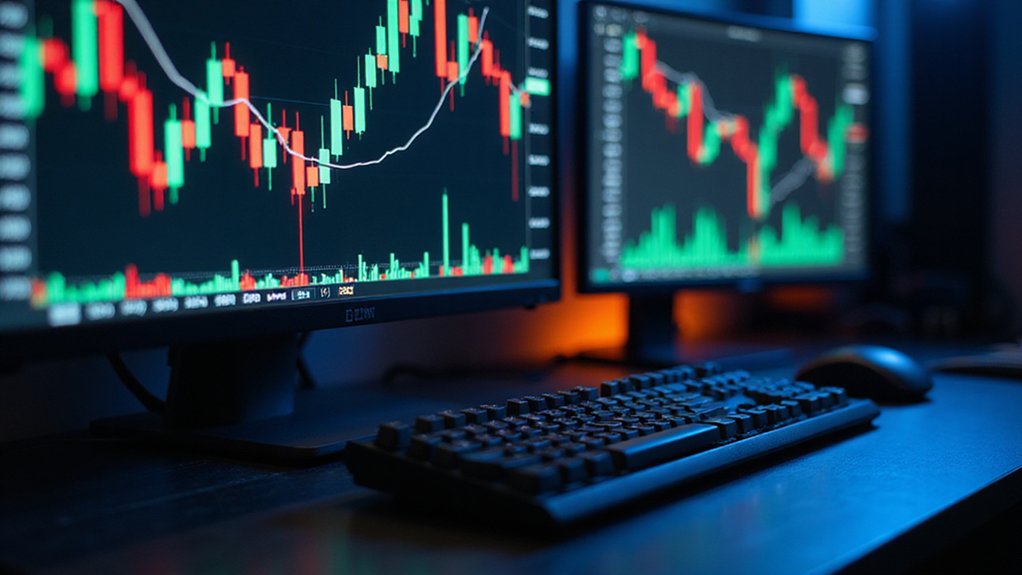Cryptocurrency markets in 2025 exhibit newfound resilience, weathering tariff-induced volatility while maturing beyond knee-jerk fluctuations. Regulatory clarity serves as the linchpin for institutional adoption, with jurisdictions crafting diverse frameworks that sophisticated crypto enterprises navigate with increasing dexterity. AI integration enhances transaction efficiencies and security protocols, while DeFi and stablecoins solidify their position as legitimate financial instruments. Specific currencies—notably XRP, UNUS SED LEO, and Solana—outperform competitors through substantive utility and ecosystem growth. The horizon reveals even more transformative developments beneath these surface-level shifts.

The market’s resilience merits particular attention, having weathered significant volatility triggered by U.S. trade tariffs in Q1. This fortitude indicates maturation beyond reactionary fluctuations toward sustainable growth patterns, though prudent observers maintain healthy skepticism about declarations of permanent stability. Bitcoin has demonstrated remarkable strength, stabilizing in Q2 after the tariff-induced market turbulence.
Regulatory clarity emerges as the fulcrum upon which mainstream adoption balances.
Different jurisdictions continue implementing varied approaches, creating a regulatory mosaic that cryptocurrency enterprises must navigate with increasing sophistication. The resultant compliance frameworks, while occasionally Byzantine in complexity, ultimately strengthen investor confidence—particularly among institutional actors previously hesitant to enter the space.
The integration of artificial intelligence with cryptocurrency infrastructure represents perhaps the most consequential development of 2025.
AI-enhanced protocols have demonstrably improved transaction efficiencies and security measures while enabling more sophisticated trading strategies.
This technological symbiosis, however, introduces novel regulatory and ethical considerations that remain inadequately addressed.
Decentralized finance continues its remarkable trajectory, establishing itself as a legitimate complement to traditional financial systems rather than merely an experimental alternative.
DeFi’s growth correlates strongly with stablecoin expansion, the latter facilitating cross-border transactions with unprecedented efficiency.
This synergy creates compelling investment opportunities while simultaneously democratizing access to financial services. Enterprises are increasingly accepting stablecoins for payments as they offer the cheapest way for fast global payments without gatekeepers or minimum balances.
Among specific cryptocurrencies, UNUS SED LEO and XRP have demonstrated exceptional performance in 2025, buoyed by unique market conditions and, in XRP’s case, favorable resolution of protracted legal challenges—a testimony to the market’s increasing discrimination between projects with substantive utility versus mere speculative vehicles. Investors are increasingly drawn to Solana’s capabilities due to its exceptional transaction speed and growing ecosystem of decentralized applications.
Frequently Asked Questions
How Will Cryptocurrency Taxation Change by 2025?
By 2025, cryptocurrency taxation will undergo significant transformation with the implementation of Form 1099-DA reporting requirements, forcing exchanges to disclose gross proceeds to the IRS.
Taxpayers must identify specific crypto units sold or default to FIFO accounting—a potentially costly proposition for the disorganized investor.
The regulatory vise tightens further with enhanced enforcement mechanisms, while long-term capital gains (0-20%) and short-term gains (taxed as ordinary income at 10-37%) remain structurally unchanged.
Record-keeping, once optional, becomes imperative.
Which Countries Will Lead Cryptocurrency Adoption in 2025?
By 2025, cryptocurrency adoption will likely be led by a curious amalgamation of early movers and adaptive powerhouses.
El Salvador and UAE will maintain their pioneering positions, while Singapore’s regulatory finesse will attract institutional capital.
Emerging markets—particularly India and Nigeria—will leapfrog traditional adoption curves as inflationary pressures intensify.
China may rejoin the race through controlled digital yuan expansion, while Dubai’s purpose-built crypto ecosystem could become the sector’s de facto global headquarters.
Can Cryptocurrency Replace Traditional Banking Systems?
Cryptocurrency cannot wholly replace traditional banking systems, but rather seems destined to coexist in an increasingly symbiotic relationship.
While cryptocurrencies offer compelling advantages in transaction speed and cross-border efficiency, they lack the institutional scaffolding and regulatory frameworks that underpin traditional finance.
The future likely belongs to hybrid models—banks adopting blockchain technology while cryptocurrencies gradually formalize their governance structures.
(The notion that five billion account holders would suddenly abandon established systems for purely decentralized alternatives remains, charitably speaking, ambitious.)
How Will Environmental Concerns Impact Cryptocurrency Development?
Environmental concerns will fundamentally reshape cryptocurrency’s trajectory, with regulatory scrutiny and market pressure converging to demand greener alternatives.
Proof-of-Stake and other energy-efficient consensus mechanisms will likely supplant the carbon-intensive Proof-of-Work systems—Bitcoin’s energy footprint (comparable to Argentina’s) being increasingly untenable.
Cryptocurrencies investing in carbon offsets or built on sustainable frameworks may gain competitive advantage, while those clinging to resource-heavy protocols risk obsolescence in a market where environmental credentials increasingly influence investor sentiment.
What Cybersecurity Threats Will Cryptocurrencies Face in 2025?
Cryptocurrencies in 2025 will contend with a cybersecurity landscape that has evolved at an alarming pace.
Attackers will deploy AI-enhanced social engineering, sophisticated ransomware incorporating double extortion techniques, and unprecedented blockchain protocol exploits.
The geopolitical dimension—particularly state-sponsored threats targeting exchanges—adds considerable complexity.
Meanwhile, the industry’s decentralized nature (its purported strength) ironically hampers coordinated defensive responses, creating a perfect storm where technical vulnerabilities intersect with regulatory blind spots.









